Research - (2020) Advances in Dental Surgery
Prevalence of Patients Undergoing Root Canal Treatment in Single Visit and Multiple Visit Based on Diagnostic Response
Mohamad Qulam Zaki Bin Mohamad Rasidi and S. Delphine Priscilla Anthony*
*Correspondence: S. Delphine Priscilla Anthony, Department of Conservative Dentistry and Endodontics, Saveetha Dental College and Hospital, Saveetha Institute of Medical and Technical Sciences, Saveetha University, Chennai, India, Email:
Abstract
The dental pulp is a delicate connective tissue. It includes ample blood vessels, lymphatics, nervous fibers, and undifferentiated cells. Patients with irreversible pulpitis often need strong analgesics and may have difficulty locating the precise tooth that causes pain. The aim of this present study is to evaluate the association of gender and tooth involved in single visit/multiple visit root canal treatment based on the diagnostic test response. 3170 patients underwent Single visit RCT, and 4140 patients underwent Multivisit RCT were assessed and examined for the diagnostic test done, teeth involved and gender, data entered in Microsoft excel sheet and transferred to SPSS software for statistical results. Descriptive statistics and Chi-square tests were used to determine the correlation between the variables where P-value<0.05 is considered statistically significant with a confidence interval of 95%. Within the limitations of the present study, it showed that a higher number of male patients were reported in Single visit and Multi visit RCT. Maxillary Anterior and Maxillary Molars teeth had been reported to be the highest number of teeth involved in single visit RCT, and in Multi visit RCT, Mandibular Molars were reported to be the highest in Multi visit RCT. Most of the patients who underwent Single visit and Multi visit RCT were given the diagnostic test response as Cold Test-Abnormal response. There is significant evidence to show an association between the different teeth numbers involved and the gender for patients in both the single and Multi-visit Root Canal Treatment procedure,and an association between the different teeth numbers involved and the diagnostic test responses for patients underwent single and Multi-visit Root Canal Treatment procedure as both correlations showed P-value<0.05.
Keywords
Diagnostic test response, Gender, Multi visit rct, Root canal treatment, Single visit rct
Introduction
The dental pulp is a delicate connective tissue. It includes ample blood vessels, lymphatics, nervous fibers, and undifferentiated cells [1]. The pulp is responsible for maintaining dentin vitality, maintaining its sensitivity, and providing it with the necessary substances for its repair. Dentin relies on the pulp tissue for its development and maintenance, but in turn, serves as a pulp protection barrier. As it is prone to injury due to the existence of different etiologies for the appearance of endodontic diseases, such as mechanical, thermal, electrical and chemical irritants, traumatic injuries and periodontal problems, etc. [2].
Factors such as caries or trauma that cause irritation to the pulp or periradicular tissues may lead to inflammation. The inflammatory response to pulpal injury or infection is of major clinical significance. Injury may be caused by dental procedures (iatrogenic) due to trauma or attrition. Infection may be caused by bacteria originating from caries, by microleakage from restorations or by other pathways of entry into the pulp [3]. A healthy pulp has a tremendous ability to repair and heal itself; however, often over time and with exposure to irritants, the pulp tissue is compromised by inflammation or fibrosis. Pulp injury results in cell death and inflammation [4]. The degree of inflammation is proportional to the intensity and severity of the damage to the tissue. Small injuries, such as incipient carious lesions or shallow cavity preparations, cause hardly any inflammation of the pulp [5]. In contrast, deep caries, extensive surgical procedures, or persistent irritants produce more severe inflammatory changes. Depending on the severity, inflammation duration, and the ability of the host to respond to the pulp response ranges from transient inflammation of reversible pulpitis to irreversible pulpitis and to complete necrosis [6]. These changes often occur without pain or even without the knowledge of the patient or dentist [7].
One of the classic symptoms of irreversible pulpitis is lingering thermal-induced pain. Only mild temperature changes are needed to cause pain. The initial reaction is a very severe pain to hot or cold stimuli and then lasts for minutes to hours after the stimulus is removed. Lingering pain is usually a dull pain or a throbbing pain. Spontaneous (unprovoked) pain, which may awaken the patient at night and worsen when lying down, is another characteristic feature of irreversible pulpitis [7].
Patients with irreversible pulpitis often need strong analgesics and may have difficulty locating the precise tooth that causes pain. They may even confuse the maxillary and mandibular arches (but not the left and right sides of the mouth) due to the extensive branching of dental nerve axons and perhaps fewer proprioceptive fibers in the pulp. Pulps with irreversible pulpitis without the periapical disease can sometimes be difficult to diagnose; information provided by patients and the results of pulp sensitivity tests are particularly helpful in these cases. When periapical tissues are involved, the tooth will usually be susceptible to pressure and/or percussion [8]. Dynamic changes occur in the pulp that is irreversibly inflamed and can move from chronic and asymptomatic to acute pain in just a few hours [9].
Ideally, an emergency treatment for irreversible pulpitis involves the removal of irritants, pulpectomy followed by cleaning the root canal to the level of the canal terminus, as confirmed by an electronic apex locator, intracanal medication (e.g. calcium hydroxide) and temporary restoration to prevent reinfection [10,11]. There has also been a greater tendency in recent years to provide endodontic therapy in one visit, especially in non-problematic cases where the pulp is vital. Most studies have shown a similar or lower incidence of pain following treatment with a single visit to the root canal.
However, endodontic emergencies due to irreversible pulpitis require unscheduled patient visits, cause inconvenience, and disrupt routine schedules. In such cases, the time required to intervene is often a matter of concern [12]. Given the potential time constraints and the inevitable differences between clinicians' skill levels, it may not be possible to complete a comprehensive clean-up of the canal during the initial emergency visit [11]. In addition, emergency endodontic procedures, such as other dental treatments, may be interrupted by unexpected and unfavorable 'procedural errors' [13].
We have numerous highly cited publications on well-designed clinical trials and lab studies [14- 29]. This has provided the right platforms for us to pursue the current study. Therefore, the aim of this present study is to evaluate the association of gender and tooth involved in single visit/ multiple visit root canal treatment based on the diagnostic test response.
Materials and Methods
A retrospective cross-sectional study was performed among patients undergoing root canal treatment visited the Department of Conservative and Endodontics, Saveetha Dental College and Hospital, Chennai. Data were collected by reviewing 86,000 patients between June 2019 to July 2020 based on data availability from Dental Information Archiving Software (DIAS) which 3170 patients (1621 males and 1549 females) underwent Single visit Root Canal Treatment, and 4140 patients (2242 male and 1898 females) underwent Multivisit Root Canal Treatment aged between 18 to 85 years old. All duplicated data and patients with normal response during the diagnostic test were removed from the sample size,and the valid sample size were examined for the diagnostic test done, teeth number involved, age, and gender. The diagnostic test was classified into 10 categories, which is I) Cold Test- Abnormal Response, II) Cold Test- Abnormal Response, EPT-Abnormal Response, III) Cold Test-Abnormal Response, Heat Test-Abnormal Response, IV) Cold Test- Abnormal Response, Heat Test-Abnormal Response, EPT- Abnormal Response, V) Cold Test- Delayed Response, VI) EPT - Delayed Response, VII) EPT- Abnormal Response, VIII)Heat Test- Abnormal Response, IX) Heat Test- Abnormal Response, EPTAbnormal Response, and X) Heat Test- Delayed Response. The collected data were tabulated in excel sheets and were imported to SPSS version 20 (IBM corporation). Descriptive statistics and Chi-square tests were used to determine the correlation between the variables where P value <0.05 is considered statistically significant with a confidence interval of 95%.
Results and Discussion
In this present study, a single visit, and multiple visit root canal treatment done were analyzed and correlated with diagnostic test response, gender, and tooth involved. All the single and multiple visit root canal treatments done were segregated based on different diagnostic test responses. Out of the total sample size, 3170 patients (1621 males and 1549 females) underwent Single visit Root Canal Treatment, and 4140 patients (2242 male and 1898 females) underwent Multiple Visit Root Canal Treatment.
In the single visit Root Canal Treatment, most of the patients who underwent the procedure were male patients (1621 cases, 51.1%) (Figure 1). Similar finding was reported in multi visit Root Canal Treatment where male patients encounter more than half of the total number of patients underwent the procedure (2242 cases, 54.2%) (Figure 2).
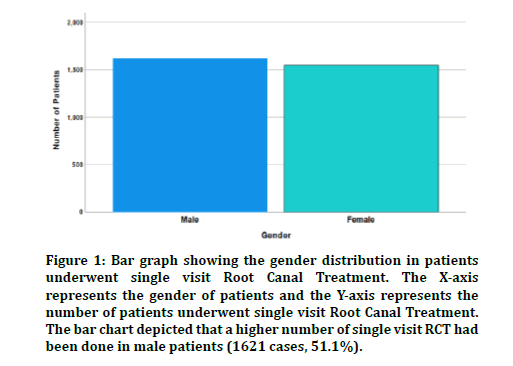
Figure 1: Bar graph showing the gender distribution in patients underwent single visit Root Canal Treatment. The X-axis represents the gender of patients and the Y-axis represents the number of patients underwent single visit Root Canal Treatment. The bar chart depicted that a higher number of single visit RCT had been done in male patients (1621 cases, 51.1%).
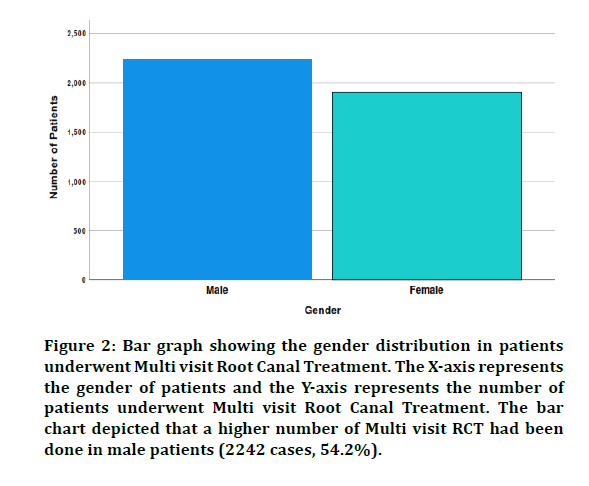
Figure 2: Bar graph showing the gender distribution in patients underwent Multi visit Root Canal Treatment. The X-axis represents the gender of patients and the Y-axis represents the number of patients underwent Multi visit Root Canal Treatment. The bar chart depicted that a higher number of Multi visit RCT had been done in male patients (2242 cases, 54.2%).
Maxillary Anterior (667 cases, 21.0%) and Maxillary Molar (658 cases, 20.8%) have been reported to be the highest number of teeth involved in single visit RCT (Figure 3). However, in Multi visit RCT, Mandibular Molars (1428 cases, 34.5%) have been reported for the highest teeth involved in treatment (Figure 4).
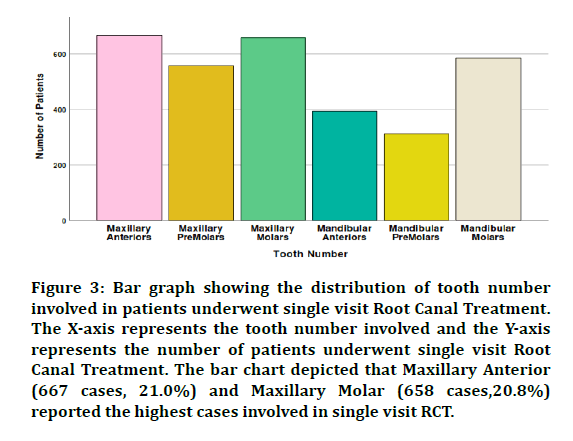
Figure 3: Bar graph showing the distribution of tooth number involved in patients underwent single visit Root Canal Treatment. The X-axis represents the tooth number involved and the Y-axis represents the number of patients underwent single visit Root Canal Treatment. The bar chart depicted that Maxillary Anterior (667 cases, 21.0%) and Maxillary Molar (658 cases,20.8%) reported the highest cases involved in single visit RCT.
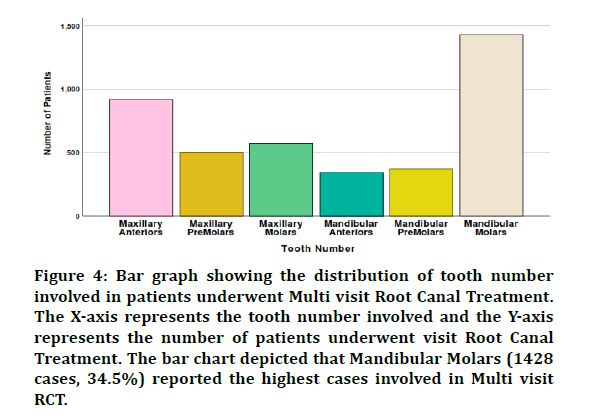
Figure 4: Bar graph showing the distribution of tooth number involved in patients underwent Multi visit Root Canal Treatment. The X-axis represents the tooth number involved and the Y-axis represents the number of patients underwent visit Root Canal Treatment. The bar chart depicted that Mandibular Molars (1428 cases, 34.5%) reported the highest cases involved in Multi visit RCT.
From the result, most of the patients who underwent single visit RCT were given the diagnostic test response as Cold Test-Abnormal response (1338 cases, 42.2%) (Figure 5). Patients who underwent Multi visit RCT also showed a similar finding, where most of the patients were given the diagnostic test response as Cold Test- Abnormal response (1647 cases, 39.8%) (Figure 6).
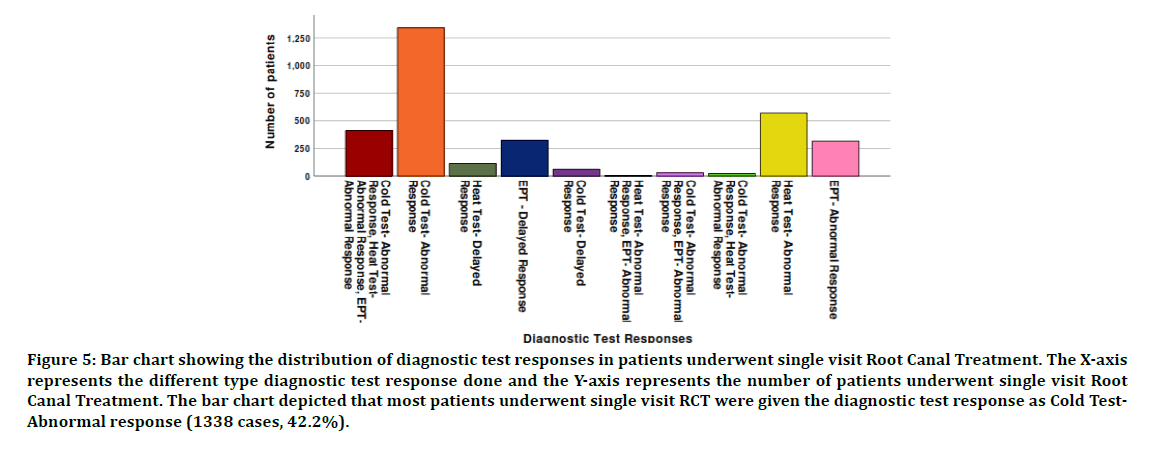
Figure 5: Bar chart showing the distribution of diagnostic test responses in patients underwent single visit Root Canal Treatment. The X-axis represents the different type diagnostic test response done and the Y-axis represents the number of patients underwent single visit Root Canal Treatment. The bar chart depicted that most patients underwent single visit RCT were given the diagnostic test response as Cold Test- Abnormal response (1338 cases, 42.2%).
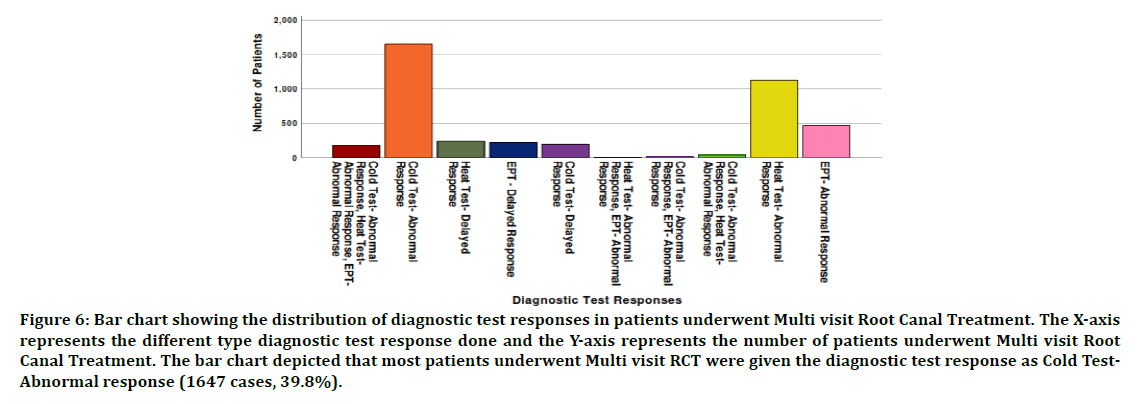
Figure 6: Bar chart showing the distribution of diagnostic test responses in patients underwent Multi visit Root Canal Treatment. The X-axis represents the different type diagnostic test response done and the Y-axis represents the number of patients underwent Multi visit Root Canal Treatment. The bar chart depicted that most patients underwent Multi visit RCT were given the diagnostic test response as Cold Test- Abnormal response (1647 cases, 39.8%).
The Chi-square test was done to show the association between the different teeth numbers involved and the gender for patients who underwent Multi visit/ Single visit Root Canal Treatment procedure, where both the results showed P-value=0.000, (P<0.05), which is statistically significant. Therefore, there is an association between the different teeth numbers involved and the gender for patients in both the single and Multi-visit Root Canal Treatment procedure (Figures 7 and 8).
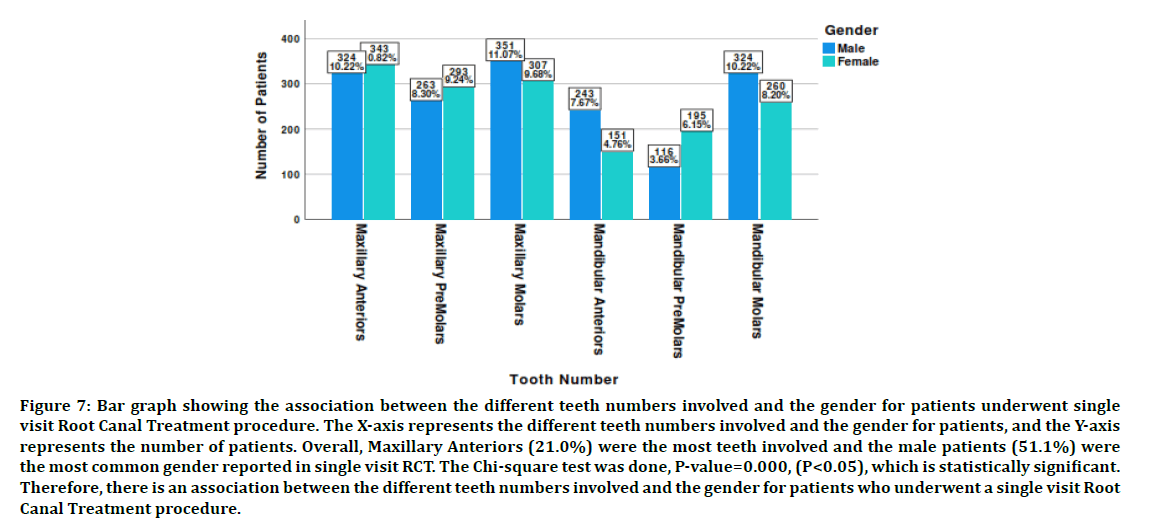
Figure 7: Bar graph showing the association between the different teeth numbers involved and the gender for patients underwent single visit Root Canal Treatment procedure. The X-axis represents the different teeth numbers involved and the gender for patients, and the Y-axis represents the number of patients. Overall, Maxillary Anteriors (21.0%) were the most teeth involved and the male patients (51.1%) were the most common gender reported in single visit RCT. The Chi-square test was done, P-value=0.000, (P<0.05), which is statistically significant. Therefore, there is an association between the different teeth numbers involved and the gender for patients who underwent a single visit Root Canal Treatment procedure.
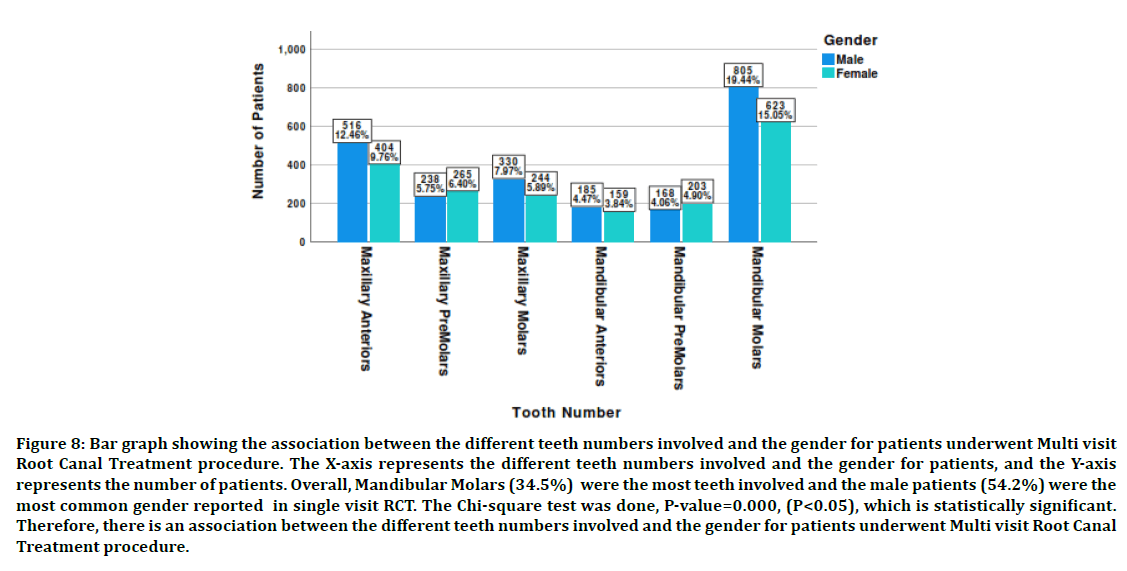
Figure 8: Bar graph showing the association between the different teeth numbers involved and the gender for patients underwent Multi visit Root Canal Treatment procedure. The X-axis represents the different teeth numbers involved and the gender for patients, and the Y-axis represents the number of patients. Overall, Mandibular Molars (34.5%) were the most teeth involved and the male patients (54.2%) were the most common gender reported in single visit RCT. The Chi-square test was done, P-value=0.000, (P<0.05), which is statistically significant. Therefore, there is an association between the different teeth numbers involved and the gender for patients underwent Multi visit Root Canal Treatment procedure.
Another Chi-square test was done to show the association between the different teeth numbers involved and the diagnostic test responses for patients underwent Multi visit/Single visit Root Canal Treatment procedure, where P-value=0.000, (P<0.05), which is statistically significant. Therefore, there is an association between the different teeth numbers involved and the diagnostic test responses for patients underwent single and Multi-visit Root Canal Treatment procedure (Figures 9 and 10).
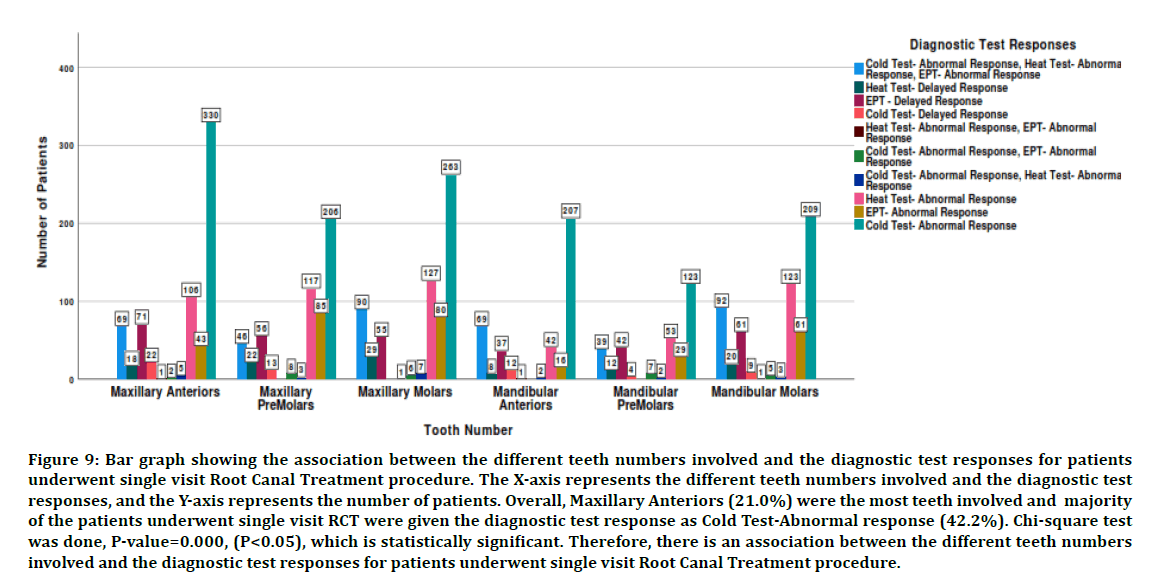
Figure 9: Bar graph showing the association between the different teeth numbers involved and the diagnostic test responses for patients underwent single visit Root Canal Treatment procedure. The X-axis represents the different teeth numbers involved and the diagnostic test responses, and the Y-axis represents the number of patients. Overall, Maxillary Anteriors (21.0%) were the most teeth involved and majority of the patients underwent single visit RCT were given the diagnostic test response as Cold Test-Abnormal response (42.2%). Chi-square test was done, P-value=0.000, (P<0.05), which is statistically significant. Therefore, there is an association between the different teeth numbers involved and the diagnostic test responses for patients underwent single visit Root Canal Treatment procedure.
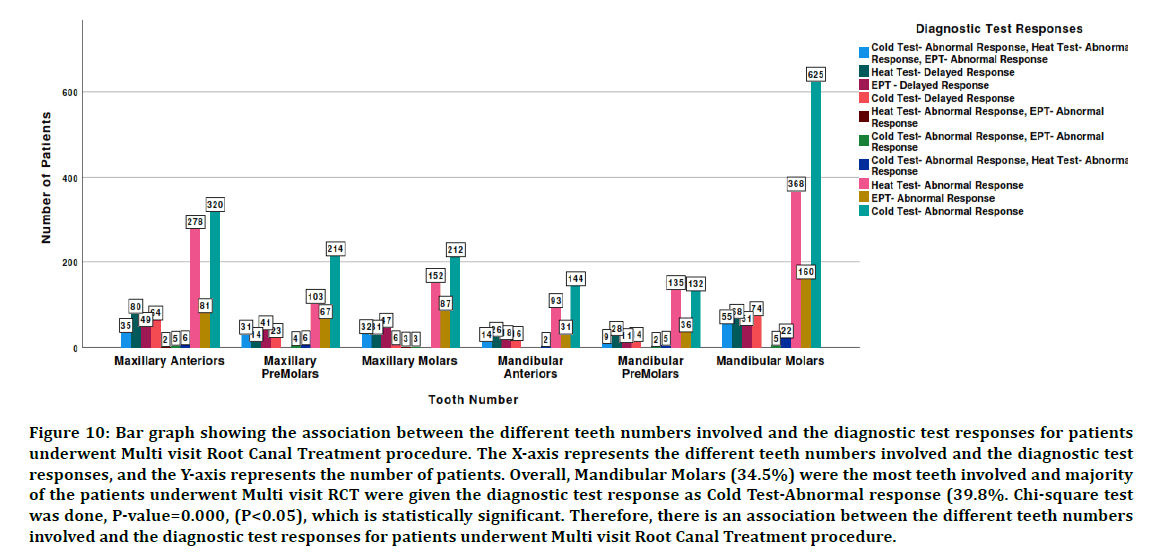
Figure 10: Bar graph showing the association between the different teeth numbers involved and the diagnostic test responses for patients underwent Multi visit Root Canal Treatment procedure. The X-axis represents the different teeth numbers involved and the diagnostic test responses, and the Y-axis represents the number of patients. Overall, Mandibular Molars (34.5%) were the most teeth involved and majority of the patients underwent Multi visit RCT were given the diagnostic test response as Cold Test-Abnormal response (39.8%. Chi-square test was done, P-value=0.000, (P<0.05), which is statistically significant. Therefore, there is an association between the different teeth numbers involved and the diagnostic test responses for patients underwent Multi visit Root Canal Treatment procedure.
In this present study, the retrospective study was used to evaluate the association of gender and tooth involved in single visit/multiple visit root canal treatment based on diagnostic test response. There is an association between the different teeth numbers involved and the gender for patients in both the single and Multi-visit Root Canal Treatment procedure (Figures 7 and 8).
In our study showed that male patients have a higher number of cases in both single visit Root Canal Treatment and Multi visit Root Canal Treatment. However, generally there is disparity in prevalence between men and women. This disparity can be explained by the fact that women are at high risk of caries relative to men. It may be due to the number of consequences, including the first dental eruption in girls relative to boys, the disparity in dental attendance due to lack of financial freedom among female patients, and the fear of the dentist and also due to the disparity in dietary habits between homemakers and workers [30].
Present study showed that the number of cases with cold tests with abnormal response were higher generally in both genders. Cold tests with abnormal responses indicate that the involved teeth have acute irreversible pulpitis and heat tests with abnormal response indicate that the involved teeth have chronic irreversible pulpitis. Both acute and chronic irreversible pulpitis are the most common causes for teeth to undergo endodontics treatment.
Acute irreversible pulpitis
Acute irreversible pulpitis usually has a sudden onset that can cause a patient to wake up at night [12]. The pain is spontaneous with a moderate to very severe intensity and persists in response to changes in temperature, such as hot and cold. The pain may be aggravated by changes in posture, such as lying down or bending over. Common analgesics are rarely effective in the control of pain [31]. In most cases, Radiographs are not useful in the diagnosis, but they can be helpful in identifying the possible cause of the disease. The tooth may be susceptible to biting pressure or percussion and, if present, this usually indicates the spread of the inflammatory process to the periapical tissues. In some cases, biting or percussion pain may indicate cracks in the tooth, and this is particularly noticeable when the crack is undermining the cusp [32].
Chronic irreversible pulpitis
Chronic irreversible pulpitis will have similar signs and symptoms but will be much less severe than those in acute cases. Patients may complain of moderate pain, which is more intermittent than continuous, and may be controlled by common analgesics [31,33]. Diagnosis may be difficult in the early stages of the disease process, as the tooth may not show any demonstrable periapical changes in the radiography or a definitive sign of tenderness to percussion [34]. However, information from the patient and pulp sensitivity tests should be useful. As the disease progresses towards the involvement of periapical tissues, periapical changes are more likely to be radiographic and clinically evident [32].
In this study, cold test,heat test and EPT were used as the diagnostic test. In cold tests, Ethyl chloride and ice have been popular for years [35,36] but CO2 ice and other coolants such as dichlorodifluoromethane (DDM) have been shown to be beneficial and better to ice and ethyl chloride [37,38].
In heat tests, typical methods used include guttapercha [36] or compound material heated to a melting temperature and applied directly to a tooth tested with a lubricant to facilitate removal of the material. Heated ball-ended metallic instruments placed near the tooth (but without touching the tooth surface), battery-powered controlled heaters, and as alternative, hot water with rubber dam as isolation can be used [10].
Electrical pulp test (EPT) is based on the premise that electrical stimuli induce ion shift across the neural membrane, thereby inducing an action potential with rapid hop action at Ranvier 's nodes in myelinated nerves [10]. The pathway for electrical current is assumed to be from the probe tip of the test tool to the tooth, along the lines of the enamel prisms and dentine tubules, and then through the pulp tissue. The "circuit" is completed by a patient wearing a lip clip or by pressing the probe handle with his or her hand; instead, the operator may have one "gloveless" hand that touches the patient's head [39]. A "tingling" feeling will be experienced by the patient as soon as the increasing voltage exceeds the pain threshold, but this threshold level differs between the patients and the teeth and is affected by factors such as age, pain sensitivity, tooth surface conduction and resistance [40,41].
There are various factors that affect the response of teeth during the diagnostic test. Gopikrishna et al. suggested that the diagnostic tests may show false positive or false negative results due to few factors such as dental development effect, multi-rooted teeth, effects of drugs, age influence, effect of periodontal disease,and effect of trauma [42].There were some limitations that were encountered which includes a limited sample size and a short duration of study time. In the future, to provide an even better outcome, a bigger sample size should be obtained, and a longer duration should be established.
Conclusion
Within the limitations of the present study, a higher number of male patients were reported in Single visit and Multi visit RCT. Maxillary Anterior and Maxillary Molars teeth had been reported to be the highest number of teeth involved in single visit RCT, and in Multi visit RCT, Mandibular Molars were reported to be the highest. Most the patients underwent Single visit and Multi visit RCT were given the diagnostic test response as Cold Test-Abnormal response. Moreover, there is significant evidence to show an association between the different teeth numbers involved and the gender for patients in both the single and Multi-visit Root Canal Treatment procedure.
There is also an association between the different teeth numbers involved and the diagnostic test responses for patients underwent single and Multi-visit Root Canal Treatment procedure.
Author Contributions
The authors have contributed to study design, data collection, analysis of data, tabulation of results, manuscript typing, and formatting and critical reviewing.
Acknowledgement
The authors thank Saveetha Dental College and Hospital, India for providing infrastructure support for the conduct of the study.
Conflict of Interest
The authors deny any conflicts of interest regarding publishing this article.
References
- Parejo Maden D, García Ortiz MY, Montoro Ferrer Y, et al. Comportamiento de las enfermedades pulpares en la Escuela“Arides Estévez”, La Habana, 2009. Revista Habanera Ciencias Médicas 2014; 13:570–579.
- Garg N, Garg A. Pathologies of pulp and periapex. Textbook of Endodontics 2014; 22–22.
- Rôças IN, Lima KC, Assunção IV, et al. Advanced caries microbiota in teeth with irreversible pulpitis. J Endodont 2015; 41:1450–1455.
- López-Marcos JF. Aetiology, classification and pathogenesis of pulp and periapical disease. Medicina Oral Patologia Oral Cirugia Bucal 2004; 9:58–62.
- Hargreaves KM, Goodis HE, Tay FR. Seltzer and bender’s dental pulp. Quintessence Publishing Company 2012.
- https://periodicos.sbu.unicamp.br/ojs/index.php/bjos/article/view/8648762
- https://pdfs.semanticscholar.org/fd83/025828881fdd85df470f6d714973189cf8e7.pdf
- Antony DP, Thomas T, Nivedhitha MS. Two-dimensional periapical, panoramic radiography versus three-dimensional cone-beam computed tomography in the detection of periapical lesion after endodontic treatment: A systematic review. Cureus. 2020; 12:e7736.
- Bergenholtz G. Inflammatory response of the dental pulp to bacterial irritation. J Endodont 1981; 7:100–104.
- Bender IB. Reversible and irreversible painful pulpitides: diagnosis and treatment. Australian Endodontic J 2000; 26:10–14.
- Radeva E. Emergency treatment of irreversible pulpitis. J IMAB 2008; 14:3–4.
- Eren B, Onay EO, Ungor M. Assessment of alternative emergency treatments for symptomatic irreversible pulpitis: A randomized clinical trial. Int Endodont J 2018; 51:e227–e237.
- Thusu S, Panesar S, Bedi R. Patient safety in dentistry–state of play as revealed by a national database of errors. Br Dent J 2012; E3–E3.
- Govindaraju L, Neelakantan P, Gutmann JL. Effect of root canal irrigating solutions on the compressive strength of tricalcium silicate cements. Clin Oral Investigations 2017; 21:567–571.
- Azeem RA, Sureshbabu NM. Clinical performance of direct versus indirect composite restorations in posterior teeth: A systematic review. J Conservative Dent 2018; 21:2–9.
- Jenarthanan S, Subbarao C. Comparative evaluation of the efficacy of diclofenac sodium administered using different delivery routes in the management of endodontic pain: A randomized controlled clinical trial. J Conservative Dent 2018; 21:297–301.
- Manohar MP, Sharma S. A survey of the knowledge, attitude, and awareness about the principal choice of intracanal medicaments among the general dental practitioners and nonendodontic specialists. Indian J Dent Res 2018; 29:716–720.
- Nandakumar M, Nasim I. Comparative evaluation of grape seed and cranberry extracts in preventing enamel erosion: An optical emission spectrometric analysis. J Conservative Dent 2018; 21:516–520.
- Teja KV, Ramesh S, Priya V. Regulation of matrix metalloproteinase-3 gene expression in inflammation: A molecular study. J Conservative Dent 2018; 21:592–596.
- Janani K, Sandhya R. A survey on skills for cone beam computed tomography interpretation among endodontists for endodontic treatment procedure. Indian J Dent Res 2019; 30:2019; 834–838.
- Khandelwal A, Palanivelu A. Correlation between dental caries and salivary albumin in adult population in Chennai: An in vivo study. Brazilian Dent Sci 2019; 22:228–233.
- Malli Sureshbabu N, Selvarasu K, Nandakumar M, et al. Concentrated growth factors as an ingenious biomaterial in regeneration of bony defects after periapical surgery: A report of two cases. Case Reports Dent 2019; 7046203.
- Poorni S, Srinivasan MR, Nivedhitha MS. Probiotic strains in caries prevention: A systematic review. J Conservative Dent 2019; 22:123–128.
- Rajakeerthi R, Ms N. Natural product as the Storage medium for an avulsed tooth–A systematic review. Cumhuriyet Dent J 2019; 22:249–256.
- Rajendran R, Kunjusankaran RN, Sandhya R, et al. Comparative evaluation of remineralizing potential of a paste containing bioactive glass and a topical cream containing casein phosphopeptide-amorphous calcium phosphate: An in Vitro study. Pesquisa Brasileira Odontopediatria Clinica Integrada 2019; 19:1–10.
- Ramarao S, Sathyanarayanan U. ‘CRA Grid - A preliminary development and calibration of a paper-based objectivization of caries risk assessment in undergraduate dental education. J Conservative Dent 2019; 22:185–190.
- Siddique R, Nivedhitha MS. Effectiveness of rotary and reciprocating systems on microbial reduction: A systematic review. J Conservative Dent 2019; 22:114–122.
- Siddique R, Sureshbabu NM, Somasundaram J, et al. Qualitative and quantitative analysis of precipitate formation following interaction of chlorhexidine with sodium hypochlorite, neem, and tulsi. J Conservative Dent 2019; 22:40–47.
- Siddique R, Nivedhitha MS, Jacob B. Quantitative analysis for detection of toxic elements in various irrigants, their combination (precipitate), and para-chloroaniline: An inductively coupled plasma mass spectrometry study. J Conservative Dent 2019; 22:344–350.
- Trowbridge HO. Pathogenesis of pulpitis resulting from dental caries. J Endodont 1981; 52–60.
- Claffey E, Reader A, Nusstein J, et al. Anesthetic efficacy of articaine for inferior alveolar nerve blocks in patients with irreversible pulpitis. J Endodont 2004; 30:568–571.
- Abbott PV. A clinical classification of the status of the pulp and the root canal system. Australian Dent J 2007; 52:17–31.
- Rogers BS, Botero TM, McDonald NJ, et al. Efficacy of articaine versus lidocaine as a supplemental buccal infiltration in mandibular molars with irreversible pulpitis: A prospective, randomized, double-blind study. J Endodont 2014; 40:753–758.
- Mcdougal RA, Delano EO, Caplan D, et al. Success of an alternative for interim management of irreversible pulpitis. J Am Dent Assoc 2004; 135:1707–1712.
- Dachi SF, Haley JV, Sanders JE. Standardization of a test for dental sensitivity to cold. Oral Surg Oral Med Oral Pathol 19667; 24:687–692.
- Davies AL, Rawlinson A. A comparison between two electric vitality testers and ethyl chloride with special reference to a newly available device. Int Endodont J 1988; 21:320–326.
- Fuss Z, Trowbridge H, Bender IB, et al. Assessment of reliability of electrical and thermal pulp testing agents. J Endodont 1986; 12:301–305.
- Jones VR, Rivera EM, Walton RE. Comparison of carbon dioxide versus refrigerant spray to determine pulpal responsiveness. J Endodont 2002; 28:531–533.
- Rowe AHR, Pitt Ford TR. The assessment of pulpal vitality. Int Endodont J 1990; 23:77–83.
- Penna KJ, Sadoff RS. Simplified approach to use of electrical pulp tester. New York State Dent J 1995; 61: 30–31.
- Kleier DJ, Sexton JR, Averbach RE. Electronic and clinical comparison of pulp testers. J Dent Res 1982; 61:1413–1415.
- Gopikrishna V, Pradeep G, Venkateshbabu N. Assessment of pulp vitality: A review. Int J Paediatr Dent 2009; 19:3–15.
Author Info
Mohamad Qulam Zaki Bin Mohamad Rasidi and S. Delphine Priscilla Anthony*
Department of Conservative Dentistry and Endodontics, Saveetha Dental College and Hospital, Saveetha Institute of Medical and Technical Sciences, Saveetha University, Chennai, IndiaCitation: Mohamad Qulam Zaki Bin Mohamad Rasidi, S. Delphine Priscilla Anthony,Prevalence of Patients Undergoing Root Canal Treatment in Single Visit and Multiple Visit Based on Diagnostic Response, J Res Med Dent Sci, 2020, 8 (7): 129-137.
Received: 15-Sep-2020 Accepted: 16-Oct-2020 Published: 23-Oct-2020
